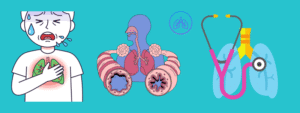Flood and Respiratory Health Hidden Dangers Affecting Your Breathing Health as Floods do not simply sweep away houses, streets, and fields, but fill people with them as they fill their lungs, their hearts, and their memories. The water finally drains, the mud dries but the air is usually still poisonous with unseen dangers that continue to harm long after the storm has passed.
The Silent Damage After the Storm
The floods leave the mould, bacteria and chemical residues which creep into the homes and schools. Each breath reminds about the catastrophe:
- Coughing children in temporary shelters.
- Older individuals with night wheezing.
- Families too scared to sleep, the damp walls stink of sickness.
The destruction of respiratory health caused by floods is not just a matter of disease names – it is the matter of how difficult it is to make a father go to work when his chest tightens, or how a mother cannot do anything but watch her child get asthmatics day by day.
Why the Lungs Suffer Most
The lungs are fragile, as wings within us. When the floods have subsided, the spores of mould and dust come up like invisible smoke, getting into these frail wings. They trigger:
- Asthma flare-ups
- Bronchitis and persistent cough.
- Severe infections in people with already weak lungs

Harms
| Small Steps That Save Lives | Description |
| Dry and Clean Quickly | Dry wet walls, carpets, and clothes within 24–48 hours. Mold grows faster than you think, and early drying prevents infestation. |
| Wear Masks While Cleaning | Even a simple cloth mask can protect the lungs from hidden mold spores and other airborne irritants. |
| Seek Fresh Air | Spend time outdoors away from damp or poorly ventilated environments whenever possible to reduce exposure. |
| Medical Checkups | Do not overlook a chronic cough or shortness of breath. Early medical attention prevents long-term lung damage. |
| Community Support | Neighbors helping each other clean and ventilate homes not only clears the air but also strengthens community bonds. |
Economy Impacts
| Impact Area | Details |
| Deaths & Injuries | Over 900–1000 fatalities reported, with millions affected. |
| Homes & Infrastructure | Thousands of houses destroyed; schools, bridges, and roads washed away. |
| Agriculture | Major crops such as rice, cotton, and maize in Punjab were severely damaged, with entire farmlands buried under silt. |
| Displacement | In Punjab alone, more than 1.2 million people were affected, and over 250,000 were displaced into relief camps. |
Health & Humanitarian Impacts
| Health & Humanitarian Impacts | Details |
| Disease Outbreaks | Stagnant floodwaters created ideal breeding grounds for cholera, dengue, malaria, and gastrointestinal infections, heightening public health risks. |
| Mental & Emotional Trauma | Families suffered immense psychological distress after losing homes and livelihoods, with children and the elderly most affected in overcrowded shelters. |
| Food & Livestock Crisis | Thousands of animals perished, grazing lands were destroyed, and widespread food insecurity now threatens community survival. |
| Climate Change Amplifiers | In Gilgit-Baltistan, melting glaciers and unstable glacial lakes intensified flooding, raising the risk of Glacial Lake Outburst Floods (GLOFs) and long-term climate hazards. |
Cross-Border Water Flows
Unexpected releases by the upstream rivers (Ravi, Sutlej, Chenab) also increased the floods in Punjab.
Floods in Pakistan are not just water damage, they leave lasting effects on health, livelihoods and memory. Every cough in stuffy houses, every child in the line to clean water, every farmer looking at flooded fields narrates the story of how people survived the increasing anger of climate.
Floods cause a lot of damage to the respiratory system of the human body, floods usually known to destroy homes, roads and farmland, yet one of the most silent and threatening impacts of floods is the one on the respiratory system of the human body. When the flood water enters the houses and schools, it creates dampness which rapidly develops into moulds. Spores start to spread within two days and when inhaled, they may cause asthma attacks, allergies and chronic bronchitis, especially in children and the elderly whose lungs are more sensitive.
With the water gone, there is one more latent danger dust and debris. Mud evaporates to fine dusts that fill the air when individuals sweep or clean up the damaged regions. These particles readily get into the lungs and result in chronic coughing, chest tightness, and chronic irritation.
Meanwhile, floodwater usually mixed with sewage and industrial waste, which generates an environment that transmits bacterial and viral diseases. Flood-affected communities may become common with pneumonia, upper respiratory infections and even flare-ups of tuberculosis.

In addition to these direct impacts, stagnant water is also a habitat to mosquitoes which cause diseases such as dengue and malaria. Although these diseases are not lung diseases per se, they impair the body and reduce immunity, exposing the lungs to further destruction. Moreover, the psychological stress of losing homes, loved ones and security following a flood can have its toll on breathing. Anxiety and trauma also associated with panic attacks, shallow breathing, and chest tightness experienced by the survivors.
After the flood, it is necessary to protect the lungs immediately and simply. Families advised to dry and clean their houses as fast as possible to prevent the growth of molds, wear masks during clearance of debris, and open the shelters whenever they can. Every person with cough, fever, or breathing difficulty needs to receive medical attention at an early stage.
Community Action
Community action, which is equally important, can mitigate the risks of respiratory illness in the long term through the assistance of neighbors to each other with clean and safe spaces. Floods can destroy walls and fields, but the invisible danger that lingers in the air can be even more destructive than the water. It is not just about disease prevention but about saving the breath of life which will make the survivors have the power to restructure their houses and their future.
Toxic chemicals
Flooding can introduce water contaminated with
- toxic chemicals
- heavy essence
- fungicides
- biotoxins
- sewage
- water-borne pathogens into buildings. Some of the toxic contaminants can be found in dried sediments that’s left behind. This becomes small air dust when agitated by daily activity such as walking and drawing.
Anything in that dried flood tide deposition the poisonous chemicals, the essence, the bio-toxins now in the air you inhale into your lungs, which may have an impact on your respiratory health. Structures did not submerged during the floods to cause respiratory problems. many of the homes we visited after Hurricane Ida experienced water intrusion through roofs, windows, and ventilation tubes and some were more than 100 long hauls away in littoral areas that bore the weight of the storm.
Floods cause the release of minute invisible particles into the air known as bioaerosols.
These are bacteria, viruses and fungal spores that move through air currents and silently penetrate lungs and cause silent infections.
Climate Change Link
Floods becoming more and more frequent and severe due to climate change. Each time there is a flood, the threat of respiratory epidemics (such as asthma outbreaks caused by mold or bacterial pneumonia) grows..
- Silent Spread of Tuberculosis (TB)
- Close contact, damp air and poor immunity contribute to the spread of TB in congested flood relief camps. This is a silent killer that can increase the current burden of TB in Pakistan.
- Indoor Air Poisoning After Floods
- Houses destroyed by floods emit toxic gases (such as formaldehyde in wet furniture and walls). Inhaling these chemicals in weeks may cause damage to the lungs without any apparent symptoms initially.
- Fungal Infections Beyond Asthma
- Floods may lead to fungal infections (such as aspergillosis or mucormycosis) that are rare and severe. The infection transmitted by inhaled spores and harmful to individuals with low immunity (diabetes, older people, children).
- Psychological Impact on Breathing
- Psychogenic breathlessness, which is the feeling of shortness of breath without any infection caused by anxiety and trauma after floods, may occur. This connection between the mind and the lungs not taken into consideration.
- Long-Term Lung Damage
Chronic bronchitis and decreased lung capacity may be the results of repeated exposure to floods. The survivors might experience good health but years later they experience permanent respiratory weakness.
Beyond Health — Healing Together
Each flood has its tale of loss, and of strength. When individuals unite, not only to share clean water, safe shelters, and open hearts, but they also form not only survival, but healing. Saving lungs is not only about protecting respiratory health; it is about giving families the power to rebuild dreams, brick by brick, breath by breath.